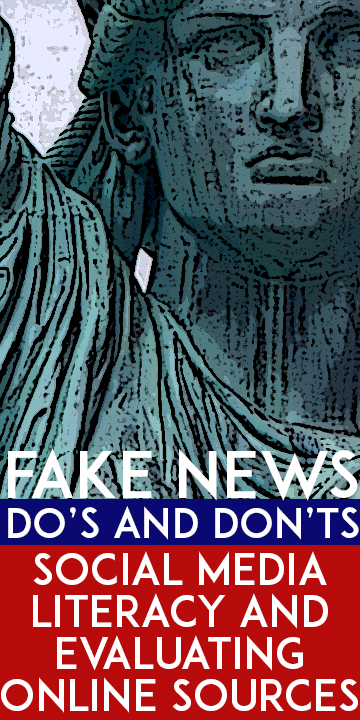6 Tips for Teaching Fake News: Digital Literacy Do’s and Don’ts

If you have students over the age of 16, they’ll be eligible to vote in the next presidential election. Will they have the information to make the best decisions for themselves and their country? If they’re making their choices based on fake news—or misinformation and disinformation—the consequences of those choices could hurt us all.
You know that you need to teach your students to be more savvy consumers of digital information who are equipped with the correct tools for evaluating online information, but what are the right ways to insure that you are doing everything you can to help them become critical thinkers and responsible citizens?
I’ve spent the past year completely overhauling my unit on How To Stop Fake News: Social Media Literacy & Evaluating Online Sources based on the latest research, and I’ve learned a lot about what works and what doesn’t.
Here are my top tips for teaching your students to be more responsible consumers of online information
1. Don’t assume you already have buy-in from your classes. You may know how dangerous it can be to spread fake news, but likely your students think that “it’s not a big deal” if they share a story without verifying it or that “it’s fine” if they make major decisions in their lives based on partly true information. These days, the term “fake news” is thrown at anyone who disagrees with our views or political sides, making it seem like the spread is inevitable. Mis- and dis-information might be so pervasive in their lives that they don’t even understand why it’s harmful.
Instead, teach your students why fake news causes real harm. If you want your students to engage in all the work they’ll need to in order to verify information in this digital age, you’ll need to convince them that it matters. So it’s important to start a unit on fake news with real-life stories of people who were hurt by incorrect information. I have found that the story of how the Nigerian government suppressed the truth about 200 girls who were kidnapped, as told in Stephanie Busari’s powerful TED Talk, is a great way to drive this point home.
2. Don’t assume your students are already sophisticated consumers of digital information. Maybe you think that the efforts of the past few years to teach students digital literacy have resulted in media savvy students whose abilities to check sources and verify information are as sleek and efficient as their newest Air-pods? Unfortunately, that is not the case. According to the “Students’ Civic Online Reasoning” Study done at Stanford in 2019, little has changed from the study they did back in 2016. Your classes might think that they know how to tell truth from fiction when it comes to online information, but if they are anything like the students in the recent study, they couldn’t be more wrong.
Instead, show them how much they don’t know. Before you get them to learn how to verify information, you’ll probably need to show them just how much they don’t know. Incorporating a fun quiz and having them evaluate multiple websites, both trustworthy and not, are my favorite ways to show teens what they need to learn. Once they realize that they are as fallible as the next student, they’ll be much more likely to want to learn how to not get duped.
3. Don’t teach your students to read vertically. If you’re giving your students a checklist like the CRAP list (currency, relevance, authority, and purpose) then you are doing them a true disservice. The students who fared the worst on the Stanford study stayed on the website, evaluating it from top to bottom. Gone are the days when all .org websites are trustworthy or all well-designed sites are legit. Sources of mis- and disinformation are way more savvy and slick that any checklist will uncover.
Instead, teach them to read laterally. As explained in the Stanford report, there are three essential questions to ask while evaluating online information. 1) Who is behind the information. 2) What’s the evidence? 3) What do other sources say? These questions cannot be answered by staying on a website. Instead, students need to click out of the site and find the answers to those questions by doing new searches and thinking like a fact checker. The best way to teach this is to explore lots of examples and give students lots of practice.
4. Don’t expect to do a simple, quick unit on fake news. Think you can do a one-off lesson on fact checking or give your classes a handout with a checklist to decide if a website is reputable and be done with it all? Sorry, those days are long gone. The internet is growing exponentially, and it is a much more complex place than it was in years past. In fact, the more biased the source of information, the better they often are at playing with our emotions, taking advantage of our cognitive biases, and designing a slick and professional-looking website.
Instead, take your time and focus on the long-game of creating critical thinkers. You’ll need to teach your students to think critically about themselves, their sources of information, and the world around them. This is not something that will happen overnight. When it comes to mis- and disinformation, our emotions and cognitive biases are so wrapped up in what we read, like, and share, that it takes a good deal of critical thinking to unravel the whole mess. Incorporating some intentional lessons that examine how fake news messes with our emotions as well as some engaging activities to teach cognitive bias are my favorite ways to get students thinking critically about themselves and the information they consume.
5. Don’t forget to talk about social media. Did you know that according to Common Sense Media, teens are more likely to get their news from social media than from new sources? Whether we like it or not, social media plays a huge role in how teens get their information. Ignoring it in your lessons because it’s too complicated and messy won’t help your students to develop the skills they need.
Instead, give students targeted lessons that focus on the specific aspects of social media. Students have so much to gain from social media, but they can also be a little blind to the tricky spots of something that has surrounded them for their entire lives. From targeted advertising to the echo chamber to extreme recommendation engines, the world of social media news can seem even more complicated to teach, but when students are aware of both the benefits and the downfalls of social media, they will be more empowered to think for themselves and not fall prey to tricky news sources.
6. Don’t encourage cynicism. One of the most dangerous consequences of the ubiquity of fake news, and the term fake news, is the belief that we can’t trust anyone and that there is no such thing as truth. When your students believe this, they are actually even more likely to fall for dangerous conspiracy theories, pseudoscience, or other manipulative journalism.
Instead, teach your students the importance of healthy skepticism and trust in the experts.It’s important to remember throughout your unit on fake news that there are experts, there is such a thing as trustworthy news, and that quality journalism does exist. The more your students examine quality journalism from the inside out, the more they’ll get a feel for it when they come across it on their own time.
Joseph Pulitzer once said, “Our Republic and its press will rise or fall together.” The health of the republic might feel like a heavy weight to put on the teens sitting in your classroom, yet it is one that they will shoulder whether they want to or not.
It’s going to be up to you need to make sure that they have the critical thinking skills they need to engage in their civic responsibilities. Helping them to find the best information possible to make good decisions is a step in the right direction.
Ready to teach your students the skills they need to be responsible citizens of the 21st century? Click here to get my complete unit on fake news, evaluating online sources, and social media literacy.
